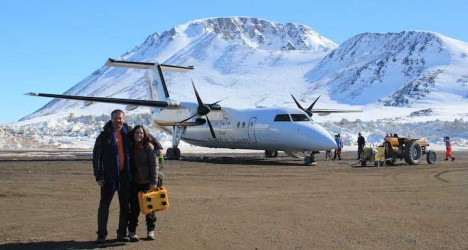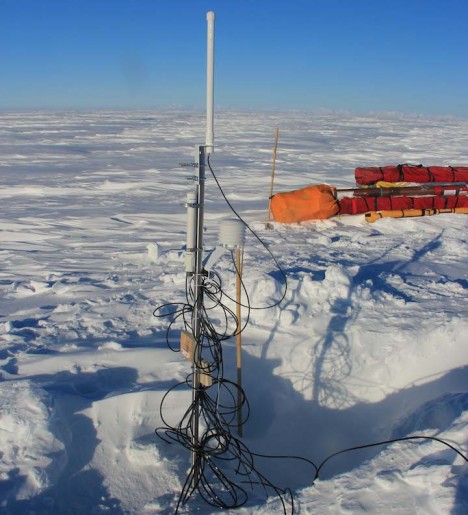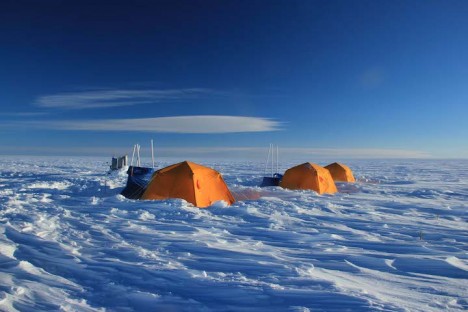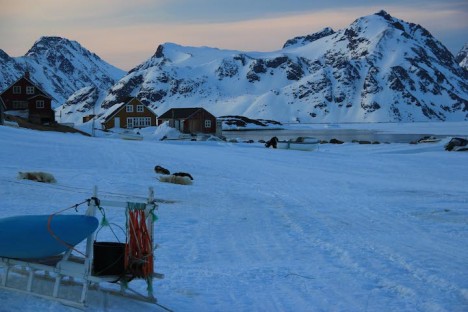Hi there!
I am writing this post from Iceland, a few days after the last team members left Kulusuk, Greenland. Back from the field, we spent five days packing up our equipment and organizing the container for the end-of-summer field campaign. Overall the firn aquifer field campaign was a success. However, since we experienced difficult weather conditions, we did not fully complete our initial goals because we were not able to bring the seismic equipment into the field (the snow surface conditions prevented us from using snowmobiles which were required for the seismic surveys). The weather is difficult in this region, which makes measurements more challenging to make. Therefore, we needed to make adjustments to maximize the science that could be done.
We spent 14 days camping on the ice sheet at a location about 130 kilometers northwest of Kulusuk, at a latitude close to the Arctic Circle. We spent three days extracting a 56-meter firn/ice core using a combination of an electromechanical drill and an electrothermal 4-inch drill provided by IDDO. We equipped the freshly drilled borehole with temperature sensors and a pressure transducer to monitor the seasonal changes of the firn aquifer temperatures and to monitor the changes in height of the water table. In the meantime, our team deployed a piezometer above, within, and below the aquifer to measure hydraulic permeability with a vertical resolution of 1 foot. In addition, aquifer water samples were collected to date the water by using different techniques. I invite you read Olivia’s blog post for further details on the water sampling. We measured ice surface velocity using a high-precision GPS from UNAVCO. Finally, we successfully used the magnetic resonance to estimate the volume of water in the in a non-destructive way as described by Lynn in our previous blog post.
In terms of weather, we experienced a five-day snowstorm with two storms back to back which dropped about 1 meter of snow. After the snowfall, katabatic winds started, blowing this freshly fallen snow at 40 knots and our tents needed hourly maintenance for about 36 hours to avoid being buried. The small mountain tent was too much work to maintain and we decided to only stay in the bigger Arctic Oven tents. At the end of the storm, important efforts were necessary to dig out camp and the cargo lines, which exhausted the team. In addition, the relatively warm temperatures during the storm (maximum at about -5˚C) got us wet and it was difficult to dry out. After 72 hours of continuous shoveling and tremendous efforts to avoid being buried and maintain camp, our PIs voted for team extraction as safety was compromised. Two days later we were picked up by the B-212 Air Greenland helicopter and after 50 minutes of travel we arrived safely in Kulusuk.
Overall, this field season was instructive and extremely helpful to plan our next field campaign which will happen in September this year. We confirmed that southeast Greenland was a challenging place to work, but we successfully collected a great hydrology data set, as well as confirmed the potential of the magnetic resonance to estimate liquid water content over a 80 by 80 meter wired loop. We postponed the radar and seismic studies for the fall campaign since we would be more likely able to bring a snowmobile to the field, crucial of the deployment of such experiments.
The spring 2015 campaign is now over. I hope you enjoyed reading the blog posts, and we now wish for a great and warm summer! Please stay tuned as we will be back in August/September for additional measurements on this part of the Greenland ice sheet, and will update the blog then.
Tags: cryosphere, drilling, Greenland, Greenland Aquifer Expedition 2015, ice












Thanks for letting us tag along from the comforts of home. And congratulations on all you managed to accomplish, despite the really really nasty conditions. There must be some “it feels so good when I stop” reactions, mixed with feeling of a job well done. Thanks again, rb
Hello,
I enjoyed this article and the work you are doing is important. The human vs. nature of that location is quite evident from your photographs but it is obvious there was calm before and after the storms as well.
Thank You.
Quite an adventure! Hope you trip in September goes well.
I really enjoyed reading about your progress, your difficulties, your experiences. The pictures were awe-inspiring and I’ve saved one as my new desktop background. Thank you for a wonderful insight and I look forward to more this Fall.
Extraordinary – Thank you!
Your work is quite adventures and meaningful for us.
see you see.. .